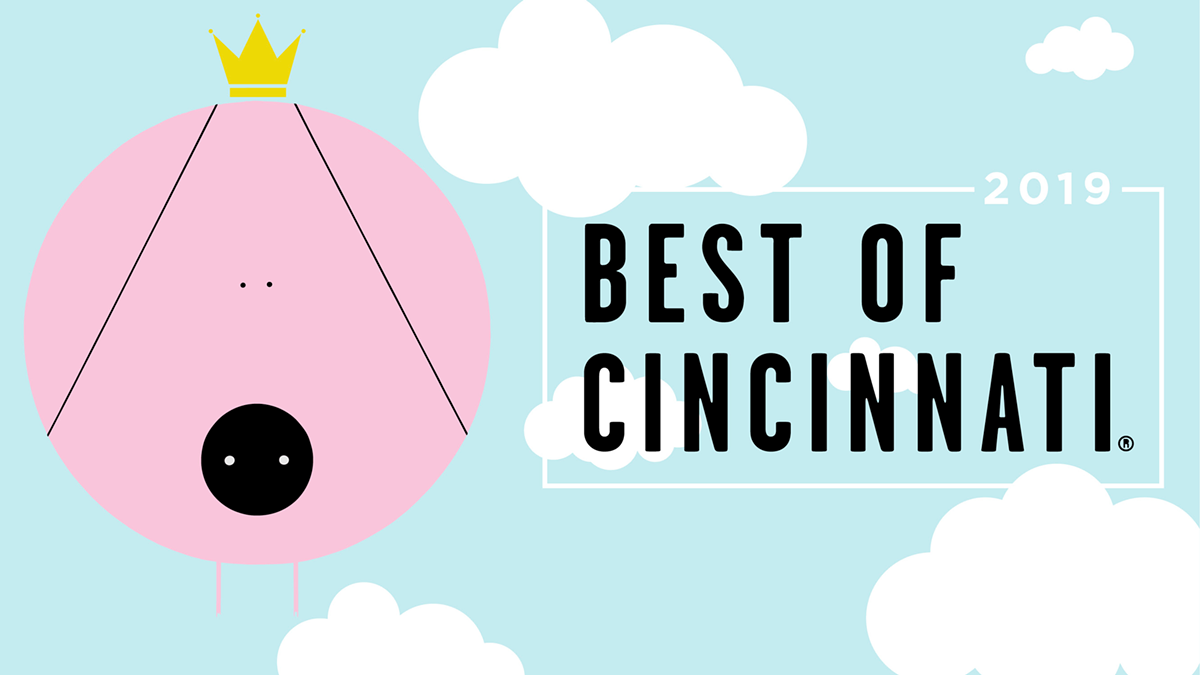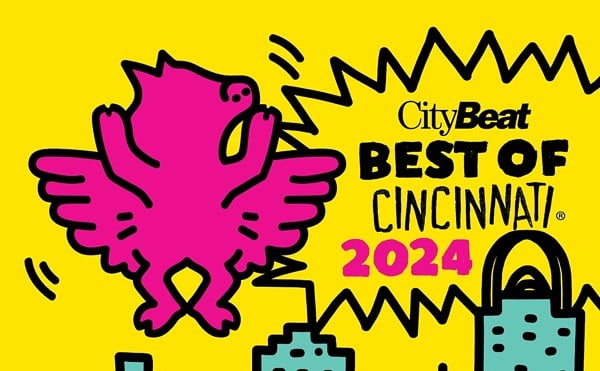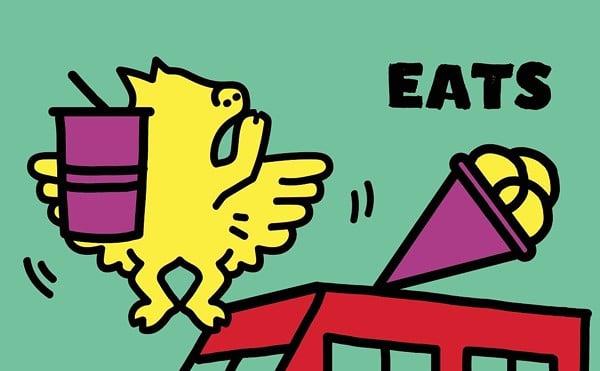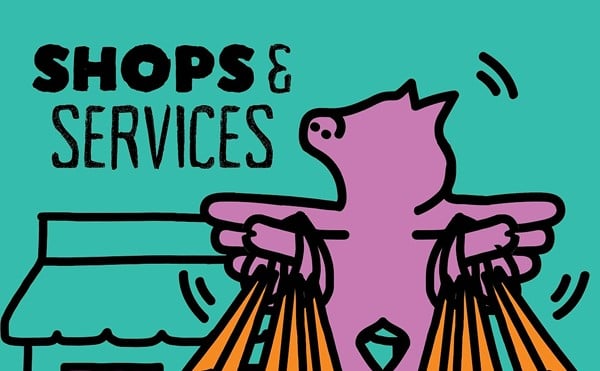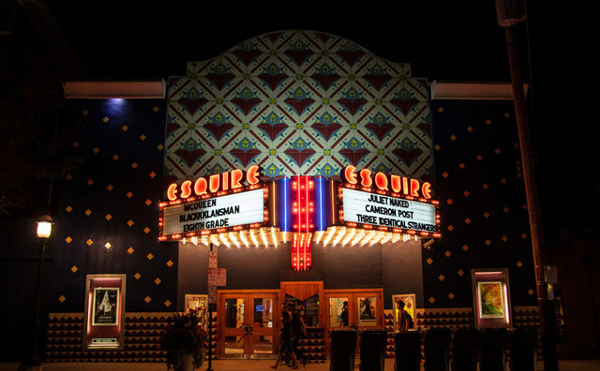This year, Cincinnati transit activists the Better Bus Coalition took it up a notch, providing free bus benches, pushing successfully for the city’s first bus-only lane during downtown rush hour and introducing a ballot initiative to boost bus funding. The coalition has done tons of social media activism around Metro’s struggles, highlighting aging buses, riders left waiting in the cold and more in daily posts. But the group takes things several steps further, too. They’ve engaged residents to create their own roadmap to a better Metro, for example. It remains to be seen whether voters will approve their proposed Cincinnati payroll tax increase, which the group estimates would cost a person in Cincinnati making $40,000 a year an extra $6.67 a month. Either way, expect the Better Bus Coalition to stay active in pushing for better transit service. Better Bus Coalition, betterbuscoalition.org.
The renovated Ziegler Park Pool is turning into not only a community hot spot, but also a hip place to see and be seen. Partly because of the location (across from Alumni Lofts in the former School for Creative and Performing Arts), partly because of the cost (daily admission is $4 for adults, with a sliding fee scale for season passes) and partly because of the features. Helmed by 3CDC, this former Cincinnati Recreation Commission pool has undergone a significant makeover to encompass three distinct sections: a zero-depth wheelchair-accessible area, an area with lap lanes and another with a diving board and rock-climbing wall. As a community-first pool, the urban swim club also offers lessons, a swim team and activities like water aerobics. But we’re here for the Adult Swim parties. During these 21-and-up nights held monthly during the summer last year, there were DJs, wine, local craft beers (and Bud Light) and food trucks. In addition, Ziegler also hosted a Dog Swim to close out the season, inviting vaccinated and well-behaved canines into the pool for a dip. Ziegler Park Pool, 1322 Sycamore St., Over-the-Rhine, zieglerpark.org.
Like a mini version of the iconic London Eye, Skystar is a 15-story “observation wheel” that went up at The Banks downtown at the end of August to celebrate the riverfront development’s 10th anniversary. The Ferris wheel features 36 glass-enclosed, climate-controlled gondolas that take up to six riders on a 12-minute spin for a unique view of the river and Cincinnati and Northern Kentucky skylines. The portable — yes, portable — tourist attraction has been traveling across America, setting up shop in cities including Norfolk, Virginia and Louisville, Kentucky to offer elevated views and a novel pop-up experience. At night, the wheel turns into a glowing orb with more than 1 million colored LED lights and casts a pretty cool neon reflection into the waters of the Ohio River. Skystar became so popular that the company extended its original stay from August to December 2018 through mid-June 2019, which means it will be around for Opening Day, the Taste of Cincinnati and Asian Food Fest. More than 100,000 people have ridden the wheel since its arrival. Skystar, 55 E. Freedom Way, Downtown, skystarwheel.com.
Monica Williams spent the last six years cooking soul food at her popular West End take-out spot Just Cookin’, often drawing lines of customers eager for her meatloaf, cornbread, ribs, greens, grilled salmon and other home-cooked favorites. Just one problem: Williams’ spot was in the historic State Theater on Central Avenue, which had to come down to make way for FC Cincinnati’s new MLS soccer stadium. The $250 million facility, helped along by $34 million in infrastructure spending from the City of Cincinnati and another $15-$22 million from Hamilton County for a parking garage, signals big changes likely for the historically predominantly black neighborhood with a median household income of just $15,000 a year. FCC and city officials have promised those changes will bring more investment, more jobs and more opportunity, but they also mean a big transition for the businesses that were once in the stadium’s footprint. Williams’ restaurant held its last day on a Friday in November 2018. The atmosphere was festive, but sad, too — the end of an era for the restaurant’s customers and for Williams, as well as for her mother, father, grandmother, nephew and niece, all of whom worked at Just Cookin’. That correlation between food, culture and family is one Williams subscribes to whole-heartedly. “Authentic soul food started in our grandparents’ homes,” she says. “It was the staple that held the family together. The glue. And we’re losing that. We’re losing our way of cooking in our community.” The move left Williams doggedly lobbying City Hall for help and hustling to find ways to keep her business afloat by catering events and cooking from pop-up locations. FC Cincinnati has pledged to continue working with her to get Just Cookin’ back up and running. What is next for Williams is still unclear, but if her grit and tenacity are any indication, you can bet she’ll still be cooking.
Greater Cincinnati has a reputation as an affordable city, at least compared to the soaring, four-figure average rents in places like New York City and San Francisco. But that’s deceptive. Hamilton County has a 40,000-unit gap in affordable housing, according to a study by the Greater Cincinnati Local Initiatives Support Corporation — a huge deficit that Over-the-Rhine Community Housing is working full-time to address. OTRCH has served its namesake neighborhood for more than four decades by working to ensure affordable housing for low-income residents and has grown to provide more than 470 units of such housing in Cincinnati. And the past year has been a big one: OTRCH has won grants and launched projects with a range of partners to bring new affordable units online. That hard work hasn’t gone unnoticed. Executive Director Mary Burke Rivers, who has led OTRCH for 25 years, was named one of 2018’s Women of the Year by the Greater Cincinnati Foundation and The Cincinnati Enquirer. Over-the-Rhine Community Housing, 114 W. 14th St., Over-the-Rhine, otrch.org.
What is it with Cincinnati and gorillas? This year, the Cincinnati Zoo fought a pitched legal battle to regain custody of Ndume, a 37-year-old gorilla the zoo loaned to the California-based Gorilla Foundation in 1991. Ndume was supposed to be a boo for Koko, the famous gorilla sign-language prodigy trained by Gorilla Foundation co-founder Penny Patterson. But Koko swiped left, so to speak, and she and Ndume never hit it off. Dating is hard. Koko passed away last year, triggering a clause in a 2015 agreement between the foundation and the zoo for Ndume’s return to Cincinnati. Ndume is the last gorilla at the Gorilla Foundation, and the Cincinnati Zoo and other groups, including People for the Ethical Treatment of Animals (PETA), have suggested he has been isolated and could receive better care and opportunities to engage with other gorillas at a larger facility. In legal filings, the Cincinnati Zoo called his return “urgent.” The only problem? The Gorilla Foundation didn’t want to let Ndume go, saying the trip back to Cincinnati could kill him. (We all have that high school friend who went to college in the Golden State and now feels the same way, right?) But after a lawsuit, a federal judge ordered Ndume’s return to the Queen City. Cincinnati Zoo & Botanical Garden, 3400 Vine St., Avondale, cincinnatizoo.org.
Architect Terry Brown was a University of Cincinnati professor of architecture and interior design, but to most in our region he’s known as the guy behind Hyde Park’s famed “Mushroom House.” Guests at street level will notice a winding entry staircase and misshapen exterior constructed of metal, glass, ceramic and warped wood shingles, suggesting a fairy tale or bizarre, otherworld-esque appearance that looks like a very large mushroom. The one-bedroom, one-bath 1,260-square-foot structure was built by Brown and his students from 1992 to 2006, and served as a second residence for Brown until his death in 2008. Mushroom House, 3331 Erie Ave., Hyde Park.
Yep, the rumors are true: The Capitoline Wolf statue in Eden Park was a gift from Italian dictator Benito Mussolini — and that’s not even the strangest part. The bronze sculpture depicts a she-wolf nursing two young boys, and it’s every bit as intriguing to witness in person as you would imagine. Intended to honor Lucius Quinctius Cincinnatus, Roman statesman, farmer and namesake of our dear city, the two thirsty boys represent Romulus and Remus, twins whose story relates to the founding of Rome — in fact, various images of the boys suckling a she-wolf have served as symbols of the Roman people since ancient times. So how did it get here? Mussolini sent it over for a Sons of Italy convention in 1929… sort of: He gave us an exact replica of one in Rome’s Musei Capitolini, but it was switched out for a larger one in 1931. And that is the one that has remained in place ever since. Inscribed with “Il Governatore di Roma alla Citta di Cincinnati 1931 Anno X” — “from the governor of Rome to the city of Cincinnati in 1931 (year 10 of Mussolini’s reign)” — it sits at Twin Lakes, a former quarry that now boasts two lakes and views of the Ohio River. Eden Park, 950 Eden Park Drive, Mount Adams, cincinnatiparks.com.
Cincinnati saw two iconic landmarks — The Manse Hotel and the Mt. Airy Water Towers — protected this year with local historic landmark designations. Walnut Hills’ Manse Hotel, first constructed in 1876 as a single-family home, became a vital stopover for black visitors to Cincinnati when a black businessman named Horace Sudduth purchased it in 1931. At the time, accommodations in the city were still segregated, and black residents of Cincinnati had few places where they could celebrate weddings, hold meetings of social and professional groups or put up distinguished out-of-town guests. It’s hard to overstate the cultural significance Sudduth’s new hotel would come to have for Cincinnati’s black community. The Manse was the site of Ezzard Charles’ post-match press conference after his victory over Joe Louis to claim boxing’s world heavyweight title. Cincinnati Reds first baseman Frank Robinson lived in the Manse in 1956, the year he won Major League Baseball’s Rookie of the Year award. James Brown stayed multiple times in the mid-1950s when he came to Cincinnati to record for King Records, and for a time considered it his second home. Some historians believe Hank Ballard wrote “The Twist” in the hotel before recording his version at King. Now, all that history is protected and the building could soon become affordable housing for seniors. Another Cincinnati landmark also got protection this year: Mt. Airy’s iconic water towers. The 90-year-old structures are a big deal for a few reasons. First, the seven six-story tanks and six seven-story towers (one of which houses a staircase) sit 962 feet above sea level on the highest point in Cincinnati. When they were built in 1927, they represented the first municipal water source for a number of West Side Cincinnati communities, including Cheviot, College Hill, Mt. Airy, North Fairmount, Price Hill and other nearby neighborhoods, which had previously gotten water from cisterns. The reliable water supply helped spur development of those areas. Then-Water Works Commissioner J.A. Hiller designed the structure. The towers are said to be a nod to another historic Cincinnati landmark — the Elsinore Arch that welcomes visitors to Eden Park, which was completed in 1883. That arch, built as part of the reservoir that used to occupy the park, was the first project by the city’s Water Works to use the distinctive castle-like architecture. The Mt. Airy Towers were the last. The towers are iconic enough that they’ve become the symbol used by the neighborhood’s community council and other civic bodies to represent Mt. Airy. Last year, it seemed like the water towers could face partial demolition. But Greater Cincinnati Water Works announced they have a plan to keep the towers intact and Cincinnati City Council has given them historic protections.
One of Cincinnati’s most iconic buildings will shine a lot brighter for a lot longer while providing a home to some of the city’s most important cultural institutions thanks to a stunning $213 million restoration that launched in 2016 and wrapped up this year. The massive Art Deco Cincinnati Museum Center at Union Terminal is steeped in Cincinnati history. A group of seven railroad companies built the terminal, which opened in 1933, in the face of the Great Depression. And the building’s 106-foot-tall half dome — the largest in the Western Hemisphere — greeted thousands of people as they arrived in Cincinnati every year, including soldiers returning from World War II. At its peak, the terminal offered restaurants, clothing shops, places to shower and a number of other amenities for weary travelers. But over time, a national decline in rail travel presented an identity crisis for the station — by 1972, trains were no longer serving the terminal at all — and the space became a short-lived shopping mall in the late 1970s before falling vacant entirely. Cincinnati wasn’t willing to abandon one of its crown jewels, however. By 1990, county voters had approved a levy allowing the building to become the home of the Cincinnati Museum Center. In 1991, Amtrak resumed limited train service into and out of the building. Union Terminal was back from near-death — but there was much more work to be done. The terminal’s unique structure presented maintenance challenges, and it needed a major overhaul to keep it from crumbling due to the ravages of time, weather and water damage. In 2015, Hamilton County voters approved a levy to fund the massive undertaking of saving the building, and three years later, in November 2018, it reopened to visitors. Today, the Museum Center remains and a new occupant — the Nancy & David Wolf Holocaust & Humanity Center — has moved into a prominent spot in the terminal’s concourse mezzanine, formerly home to the Cincinnati History Library and Archives. Founded in 2000 by Holocaust survivors and their families, the Holocaust & Humanity Center’s small museum and educational programs were previously located inside Kenwood’s Rockwern Academy, a Jewish community school. The new center now has roughly three times more exhibition space than it had previously, and the location is especially poignant given that Holocaust survivors arriving after World War II got their first taste of the city when they entered Union Terminal. That history — plus countless others — is preserved thanks to the renovation. Cincinnati Museum Center at Union Terminal, 1301 Western Ave., Queensgate, cincymuseum.org; holocaustandhumanity.org.
In 2018, local immigration activists stepped up to help those caught in the political crosshairs of a new, “zero tolerance” immigration push. A multi-generational, multi-organizational, interfaith effort led by organizations like the Intercommunity Justice and Peace Center, the Cincinnati Interfaith Workers Center, Transformations CDC, immigration attorneys and activists is seeking to provide legal help, shelter, advocacy and other aid for immigrants from vulnerable groups who are seeking asylum in the United States from violence, war and poverty in their home countries. The movement comes after the election of President Donald Trump, who has made intense and often factually-inaccurate claims about immigrants and who has pushed for tighter restrictions on asylum claims and refugee aid. These organizations give us heart that, regardless of the political winds blowing, there are those among us who recognize our shared human dignity.
The City of Cincinnati’s move toward renewable energy is an encouraging, ongoing effort to do our part in avoiding a grim environmental future. The city has achieved an 18.4 percent reduction in greenhouse gas emissions since it started measuring those emissions in 2006, recently built one of the country’s first net-zero energy use police stations, and greatly increased the use of solar panels and other renewable energy technology. Late in the year, city officials signed a contract that will provide 100 percent renewable energy to many city buildings and functions, saving the equivalent of 650,000 trees or 28 million pounds of coal a year. And the efforts aren’t done yet: Officials have set their sights on making all municipal energy use green-friendly by 2035.
They appeared out of the blue one day last spring, setting up roosts around Cincinnati’s downtown basin. And as the flocks grew, people developed some opinions. Oh, do we have opinions about all those rentable, smartphone app-driven Bird and Lime scooters. Some folks grew to love them faster than you can zip from OTR to The Banks on two wheels. Some folks loathe them with the intensity of a million tiny electric motors all propelling riders right toward your shin bones. There have been a couple reports of injuries due to the scooters and more than a few impassioned defenses of the dockless devices as efficient means of urban transportation. Other cities, including San Francisco and Indianapolis, banned the scooters. But Cincinnati officials have embraced them, at least to a degree, setting down some basic laws in an attempt to keep them off the sidewalks but otherwise letting them glide along. Bird, bird.co; Lime, li.me.
Move over, Fiona (don’t, really; we still love you): Kendi the black rhino is gunning for the Cincinnati Zoo & Botanical Garden’s sassy baby spotlight. In October, the black rhinoceros tot nipped the index finger of a guest who was on a behind-the-scenes tour with zoo staff. The guy was fine and walked away with minor injuries while the spunky Kendi took the “all publicity is good publicity” idiom by the horns and stole 15 minutes of fame from everyone’s favorite hippopotamus. However, Kendi, whose name means “the loved one” in Swahili, should have a fan club in her own right: Mama Seyia gave birth to Kendi in July 2017 and she was the first black rhino born at the zoo since 1999. Listed as critically endangered, the International Rhino Foundation says there are less than 5,500 black rhinos in the wild because of threats like poaching — the animal’s horns are highly sought after in traditional medicine and to craft accessories — so maybe it’s a good thing little Kendi’s packing some attitude. If you want to help rhino conservation efforts, the zoo sells Rhino Rembrandts, original works of art painted by their Sumatran, black or Indian rhinos as an enrichment activity. Money raised through the artwork directly helps the zoo support conservation initiatives. Cincinnati Zoo & Botanical Garden, 3400 Vine St., Avondale, cincinnatizoo.org.
At long last, after months of delays, Ohio’s medical marijuana program kicked off in the waning days of 2018. The system was supposed to be operational by last September, but the process saw a number of road bumps, including legal challenges from some businesses that applied to grow or dispense medical marijuana. Now, authorized physicians can use the state’s registry, which opened Dec. 3, to recommend medical marijuana licenses to patients suffering from conditions like cancer, AIDS, post-traumatic stress disorder and a number of others. The state then confirms the patient’s identity, after which the patient or their caregiver can sign up for a license that allows holders to purchase marijuana from certified dispensaries. The program has been popular so far — dispensaries sold roughly $1.2 million worth of marijuana product through late February of this year. That’s about 160 pounds of medical marijuana in various forms. As of March, more than 19,000 patients and 973 caregivers had received licenses, and 16 large and small cultivators and nine dispensaries had gained certificates of operation from the state. Ohio medical marijuana, medicalmarijuana.ohio.gov.
Loyal National Public Radio listeners in Cincinnati are hearing a new voice during their lunch hour — one with a broad knowledge of the Greater Cincinnati region. Longtime news hound Michael Monks grabbed the prestigious gig hosting Cincinnati Edition on WVXU from noon to 1 p.m. on weekdays this year. Monks took the reins for the role from esteemed Cincinnati expert Dan Hurley, who stepped in as interim host when the show’s last permanent host, Mark Heyne, left to pursue other opportunities. As the founding publisher, editor and reporter of Northern Kentucky news website River City News and an instructor at Ivy Tech Community College in Lawrenceburg, Indiana, Monks brings a wide-ranging sensibility to a show that has at times been tightly focused on city issues. Monks’ broader scope has been apparent from his very first show: an exploration of the divides — and opportunities for collaboration — between both sides of the Ohio River. WVXU, wvxu.org.
If you’ve driven on any highways near Queensgate recently, you’ve definitely seen it: the red brick, 1890s-era warehouse with the bright lime green geometric addition on the east face of the building. It’s local firm Elevar Design Group’s new showspace — a home for its 80 employees, yes, but also a way to flex the group’s architectural design skills. That cool green box contains a break room, event space (complete with a kitchen) and sliding garage doors that open up onto a rooftop deck. The unique details continue on the interior: A light-filled, three story atrium featuring the warehouse’s original wooden beams. Visitors and employees can take your standard elevator or custom wooden stairs up, but should probably try the lime-green, curving slide for the ride back down. The new HQ is the perfect spot from which to launch Elevar’s next big project: helping design FC Cincinnati’s new stadium just north in the West End. Elevar Design Group, 555 Carr St., Queensgate, elevar.com.
As Cincinnati continues to experience a huge resurgence in development, more and more people have begun to wonder whether the city should be incentivizing things like housing affordability when it makes deals with developers. Cue Over-the-Rhine community group Peaslee Neighborhood Center’s Equitable Development Rubric, which looks to give Cincinnati’s community councils tools to ask for more of what they need from those pitching big development projects like apartment buildings. Those community councils provide recommendations to City Hall about deals that can erase hundreds of thousands of dollars in tax liabilities for large projects for up to 15 years. Supporters of the rubric say the city should ask for more in return — a percentage of housing units that are affordable to low- and moderate-income people, for example, or fair wages for construction workers building those projects. Will the idea catch on? It could. Some council members have asked the city to study similar criteria for tax deals, and at least a few community councils have already approved Peaslee’s rubric. Peaslee Neighborhood Center, peasleecenter.org.
In this politically passionate age, any proposal requiring public input can become a burning battle of words and hurt feelings. And there are few places in Cincinnati that have more ardent supporters than Burnet Woods and the Clifton Cultural Arts Center. So when the CCAC floated a proposal to build its new home in the 90-acre park wedged between the University of Cincinnati, Clifton and Avondale, we expected acrimony. But we were pleasantly surprised. Both CCAC supporters and those who want the woods left alone made impassioned, reasonable and civil arguments for their side of things, and as the public debate went on, it seemed more and more like a win for the city either way. The beloved arts institution needs a new home after Cincinnati Public Schools took back the grand old Clifton School building the CCAC had been leasing. But changes to the woods have been touchy in the past. As land initially leased to the city by wealthy Cincinnatians Robert Burnet and William Groesbeck in 1874, the park encompassed more than 170 acres. After the city purchased most of the land outright, it lopped off 74 acres that in 1895 became home to UC. Half a century later, the city gave UC another 18 acres now occupied by the College of Design, Architecture, Art and Planning and other buildings. Since then, some fans of the park have been increasingly vigilant about proposed alterations. Voters in 2015 rejected Issue 22, a controversial charter amendment suggested by Mayor John Cranley that would have created a fund for big changes to the woods as well as many other parks. The Cincinnati Park Board of Directors listened carefully and, at least this time around, opted against CCAC’s proposal. “As painful as the Burnet Woods process was, it was a good process,” board member Kevin Flynn said after the vote. “It shows that reasonable people can disagree reasonably.” We agree. Long live the CCAC. Long live Burnet Woods. Burnet Woods, 3251 Brookline Ave., Clifton, cincinnatiparks.com.
Let’s face it, Cincinnati politics is always a little weird. But this past year was, to put it simply, just plain wild, man. First, there were dueling allegations about gender discrimination and overtime pay malfeasance in the Cincinnati Police Department. That led to the dismissal of a top CPD official by City Manager Harry Black on charges of insubordination. That, in turn, (are you still with us here?) led Mayor John Cranley to ask for Black’s resignation. But Black refused, leading to an unprecedented weeks-long standoff between the city manager, Cincinnati City Council and the mayor. Council, which needed to vote to fire Black, refused to do so before an investigation and also balked at the cost of a proposed severance package. Cranley wanted Black gone as soon as possible, saying that his request that Black resign came after years of complaints from city employees about intimidation and retaliation by the city manager. Black protested his treatment at the hands of Cranley, and his supporters on council and among African-American groups like the local NAACP said he was forced out. Prior to Cranley’s request that Black resign, the city manager said a small “rogue element” within CPD was working to undermine the police chief and the city’s Collaborative Agreement police reforms. Black denied he had done anything wrong, alleged the mayor was involved in shady development deals and held on for dear life until there were enough votes on council to usher him out the door. He resigned minutes before a Saturday special meeting of Cincinnati City Council could vote to fire him last spring. Black received eight month’s salary and benefits — a severance package worth about $274,000. Council’s vote ended the bizarre stalemate — but the incident sparked conversations about the city’s unusual form of government, which splits power between the mayor and city manager, as well as a debate about racial tensions within city government. Months later, ghosts from the standoff continue to float around. Texts between five Democratic council members about the situation and other city business were the subject of a lawsuit by conservative activists, who say they represent violations of Ohio’s open meetings laws. The entire incident didn’t exactly buttress public faith in City Hall, nor did a $101,000 settlement the city paid to settle the lawsuit or the harsh words a county judge had for council. Oh yeah, the release of 26,000 texts sent among council members — some of them insulting to others — probably didn’t help either.

